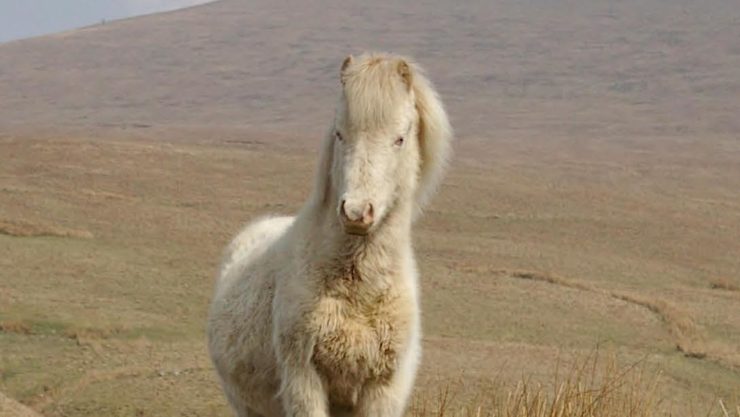Ponies are iconic. Ponies are a legend. They’re a catch phrase for the impossible dream. “Sure, and I want a pony.”
There’s history there. Horses have been solid working partners in many regions of the world, working on farms, in mines, in the woods, and in war. Ponies—who are not baby horses; they’re born small and mature small, sometimes very much so—have made notable contributions, for example in mines in the Britain and elsewhere, and as all-around working animals in the Shetland Isles. They’ve lived wild, too, in the Dales and on the Fells, and on the other side of the Atlantic, famously on the barrier islands of Chincoteague and Assateague.
Technically “pony” is a size designation: any mature equus caballus standing 14.2 hands (58 inches/147cm) at the withers is considered to be pony size, though certain breeds are called horses in spite of it—such as Icelandic horses and the tiny miniature horses. There’s a somewhat slippery definition of a pony as being stockier, shorter-legged, bigger-headed, and much hairier than a horse, and also smarter (or at least wickeder) and longer-lived. But that’s flexible, too.
Basically, a pony is what people decide it is. The ultimate image is the Thelwell pony, the rotund, furry, powerfully opinionated mount of the tiny, equally rotund, always at a disadvantage, usually female child.
That image is probably a Shetland. Shetlands run on the small side, sometimes very small—it’s one of the root stocks of the American Miniature Horse. Originally they come from the Shetland Isles, where their small size and extreme furriness represent a successful adaptation to subarctic climate and minimal forage. A pony needs very little fodder to thrive, and can actually suffer, even fatally, if fed too much rich feed—as all too many owners of ponies have discovered.
The other icon of ponydom is the Welsh pony. This is the beauty queen of the genre, with a history that goes back (so they say) to prehistoric Britain. Boudicca may have hitched its ancestors to her chariot. Roman cavalry mounts might have interbred with these native equines. Certainly there’s Arabian in the modern version: those slender legs and exquisite heads are distinctive.
The Welsh Pony registry divides the breed into four size classes, Sections A (the smallest, known as the Welsh mountain pony) to D (actually attaining horse size, as the Welsh Cob). All four sections have a similar look, temperament, and way of going, and at the Cob end of the size range, Sections C and D, are quite comfortable and attractive mounts for adults.
This is notable in equestrian terms. Very small horses or ponies (including Icelandics and Mongolian horses, and Shetland ponies) were and are ridden by grown humans—Genghis Khan conquered a good part of the world with an army of horses that averaged around 13 hands and often well under, and Icelandics carried Vikings for centuries (and both breeds still do). But in the West, especially the English-speaking West, ponies have been relegated more and more to children.
The principle is that a child begins on a small pony, most likely a Shetland. As she grows, she graduates to a larger one, probably a Welsh. When she approaches her adult height, she is presented with a mount suitable for an adult, often a Thoroughbred, though Warmbloods have come into vogue over the past few decades.
There’s been pushback against this progression, especially among older women riders. Comes a point when a large, strong, spirited (read spooky) horse becomes exhausting if not outright dangerous to ride. This has led to a resurgence of the smaller horse, often a nice sensible cob with nice sensible gaits. Welsh Cob, small Iberian or Quarter Horse, Arabian, Lipizzaner—all these breeds and more are becoming more popular especially in dressage. There’s even a show for them in the US, the National Dressage Pony Cup and Small Horse Championships, open to any horse or pony under 16 hands (64 inches/163cm).
Which is kind of ironic considering that the vast majority of horses historically have been under 16 hands, but that’s how the world tends to work. Animals get bigger as humans get bigger, until somebody decides enough is enough.
The cultural imagination however is still captivated by the idea of the pony. A pony is a child’s dream. The city child, the child without access to or resources for horses, the child who’s read all the books and watched all the movies (and they are legion), will hope and beg for a pony. It’s the ultimate gift.
And it is, as horses go, small. “I can keep it in the backyard. Or in the park. Or even in my room. I can groom it and feed it and ride it. It will be my best friend.”
Grim reality doesn’t necessarily make any difference. Shoveling manure is part of the dream. Pony brain—that infamously wicked intelligence and that happy resistance to human whim and will—is welcomed as a challenge. Pony smell? Bliss. Pony breath? Ambrosia.
Not every child stops dreaming of a pony when she (or he or they) hits adulthood, either. Horsekids come in all ages, and pony dreams can live a lifetime.
Photo credit Samuel Hinton, licensed under the Creative Commons Attribution-Share Alike 3.0 Unported, 2.5 Generic, 2.0 Generic and 1.0 Generic license.
Judith Tarr is a lifelong horse person. She supports her habit by writing works of fantasy and science fiction as well as historical novels, many of which have been published as ebooks by Book View Cafe and Canelo Press. She’s even written a primer for writers who want to write about horses: Writing Horses: The Fine Art of Getting It Right. Her most recent novel, Dragons in the Earth, features a herd of magical horses, and her space opera, Forgotten Suns, features both terrestrial horses and an alien horselike species (and space whales!). She lives near Tucson, Arizona with a herd of Lipizzans, a clowder of cats, and a blue-eyed dog.










